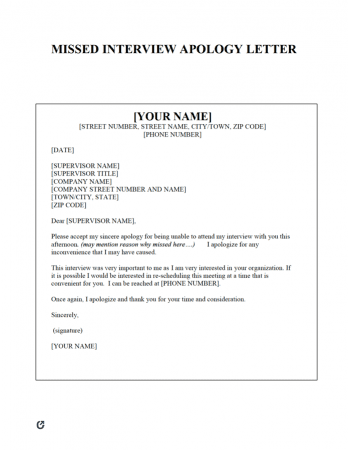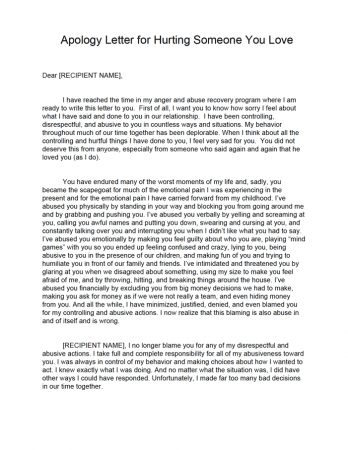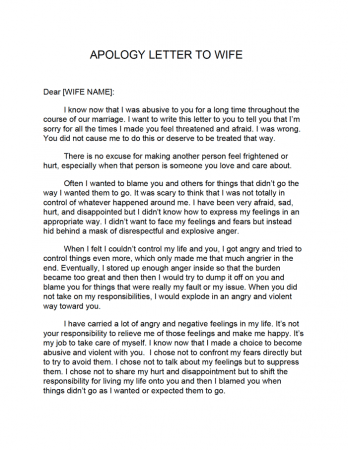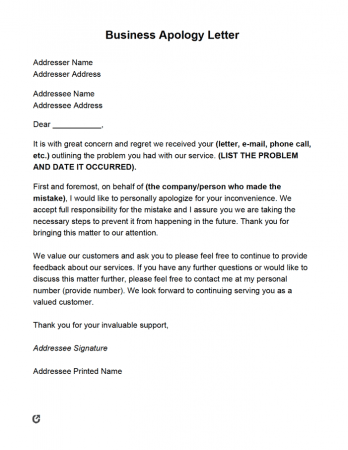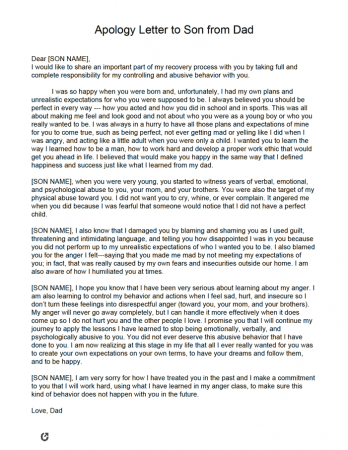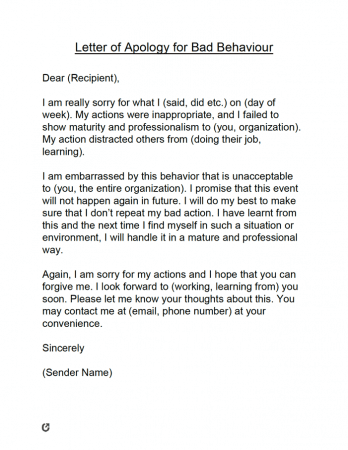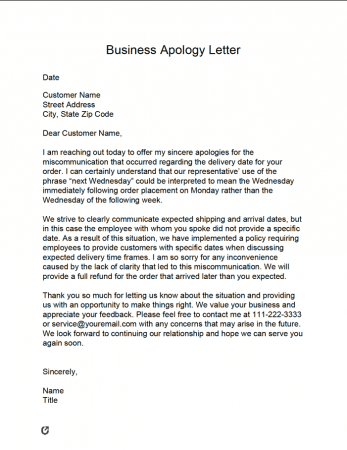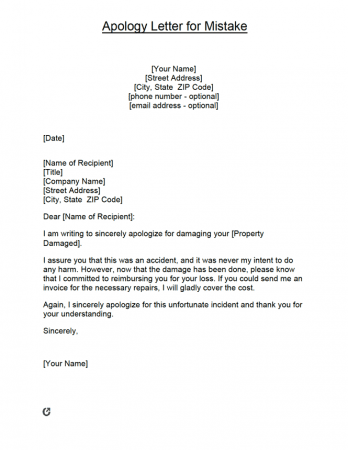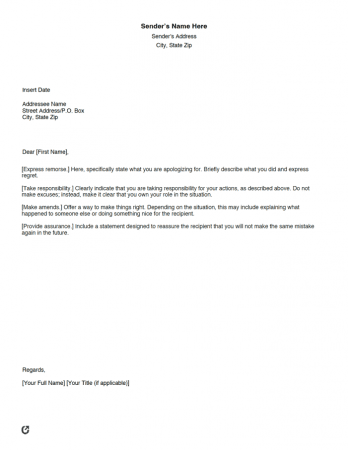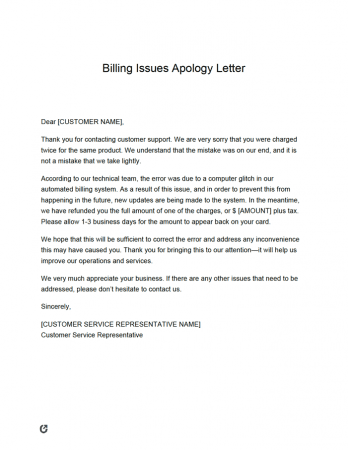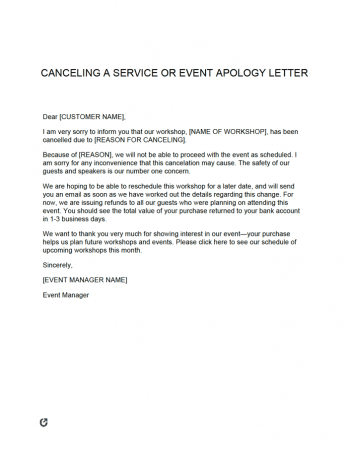Apology Letters
An apology letter is a formal and sincere expression of regret about someone’s mistake. An apology letter can be an email or physical document. People write one for a variety of scenarios. A colleague may apologize for an oversight that caused frustration or delay for another. A friend may apologize for hurting their friend’s feelings. A company may apologize on behalf of an ousted employee. Regardless of the situation, all apology letters share similar qualities: the writer takes responsibility, acknowledges the negative impact of their behavior, and seeks amends.
Table of Contents |
Apology Letter Templates
Types of Apology Letters
In any social interaction, there is potential for mistakes and missteps. Someone who has acted irresponsibly or inappropriately may cause another person to feel frustrated, have hurt feelings, or experience setbacks. Here are common types of apology letters.
- Private: This apology letter is usually between two people, such as romantic partners, family members, or friends. An apology letter may be appropriate if someone has upset another or had a miscommunication that led to hurt feelings.
- Professional: An employee or employer may write an apology letter to express regret about actions that directly impacted business. In this situation, a good apology letter acknowledges the error, its consequences, and plans to avoid the mistake in the future.
- Third-Party: Sometimes, businesses or organizations need to apologize on behalf of someone else. The apology letter can help preserve the business relationship and show goodwill to an upset customer.
- Large Scale: An apology letter to a broader audience may be appropriate if someone has acted erroneously or inappropriately in public view. Well-known figures or celebrities issue these “mass” or “open” letters to acknowledge their mistake and hold themselves accountable.
How to Write an Apology Letter to a PrincipalWhen writing an apology letter to a professional, such as a principal, the author should appear genuine and recognize the mistake they made. Students often write apology letters to principals after they do something that goes against school policy. For example, the student may have disturbed the classroom, thus preventing students from learning, or they could have skipped class. The focus of the letter significantly depends on the wrongful act that occurred. Students who break the law, such as trespassing after hours, would use different wording than someone who spoke out in class. In the first case, a court might request the student write a letter. However, in the second scenario, a parent might ask their child to send the principal a note to say sorry. Most importantly, the student should take full responsibility and address their wrongdoing. They should emphasize the lesson they learned and promise not to commit the act again. |
Apology Letter Examples
How to Write an Apology Letter
Before writing the apology letter, determine the essentials: the act that warrants the apology, the consequences, and the plan to avoid the mistake in the future. This outline is also an excellent organizational structure to follow and will help the writing process.
- Step One – Identify the Mistake
- Step Two – Take Responsibility
- Step Three – Make Suggestions
- Step Four – Ask for Forgiveness
Step One – Identify the Mistake
Begin the letter by stating the specific mistake, oversight, or misunderstanding. A good apology letter gets straight to the point and states clearly the person’s wrongdoing. “Dear Sam, I want to apologize for forgetting to pick you up from the airport on Friday night.”
After admitting the mistake, recognize its impact. “I understand this left you stranded for hours, leading you to use an expensive taxi service and get little sleep that night.” It is also appropriate to express regret or remorse. “I deeply regret that my actions caused a major disruption to your plans.”
Step Two – Take Responsibility
Good apology letters are concise, clear, and concrete. While the writer may acknowledge the circumstances surrounding the mistake, they ultimately take responsibility, are genuine in their remorse, and seek to make amends.
Taking responsibility means identifying your mistake without making excuses or over-explaining why you made the choices you did. For example, if you broke your friend’s vase, you might say something like, “I would like to sincerely apologize for breaking your vase as I know that it meant a great deal to you.” You would not say anything along the lines of, “I apologize for breaking your vase, even though I was in a rush and did not see it.” The latter of the two apologies does not sound genuine, or like you are taking personal blame.
Lastly, make sure the letter is also timely as it shows that you are proactive and the apology means something to you. Furthermore, an apology a month or more after an incident may fall flat and be ineffective.
Step Three – Make Suggestions
To end on a positive note, suggest ways to act differently in the future. “I hope to keep better track of my calendar and follow through on my commitments.”
If appropriate, making suggestions on how you might change or avoid the mistake in the future tells the person that you have thought about it deeply. In addition, it shows that you are mature and want to change or improve to be a better family member, friend, spouse, employee, boss, or overall person. It is imperative to use the proper wording during this step not to sound arrogant, sarcastic, or condescending. Having another person proofread your letter might give you a second opinion on your tone.
Step Four – Ask for Forgiveness
Showing some vulnerability by asking for forgiveness can also be a good move. “I sincerely ask for your forgiveness, but I understand that this may need some time.”
A crucial part of apologizing is admitting that you were in the wrong. By asking for forgiveness, you show the person that you care about your mistake and want to take ownership. You also leave the conversation open-ended, allowing the recipient to consider what they feel comfortable with moving forward. It also shows that you are willing to work with them to create a solution or rebuild the relationship.
Apology Letter Samples
Reasons For Creating an Apology Letter
Although all apology letters ultimately say sorry, each type is different because of its respective audience. There may be several reasons someone writes an apology letter, such as:
- To mend hurt feelings. A fight, miscommunication, acting out of character, or betrayal by a significant other or friend warrants an apology letter. An apology letter can help ease tension and re-establish the relationship’s bond. A spouse might write an apology letter if they broke their partner’s trust by telling a secret. A friend might write one for damaging an expensive camera they borrowed.
- To fix errors. An apology letter might be helpful in a professional setting if someone’s actions created errors, deterred progress, or created setbacks in business proceedings. Employees may write an apology letter if they missed a deadline, showed up late to an important presentation, or miscalculated the budget.
- To preserve reputation. If the public or broader audience witnesses an error or mistake, an apology letter may help maintain the person’s or company’s reputation. A business might write an apology letter to a dissatisfied customer if an employee acted unprofessionally. A member of an executive board might write an apology letter to their organization if they posted offensive comments on social media. These acts show remorse and goodwill to avoid similar behavior in the future.
How to Write an Apology Letter to a CustomerWriting an apology letter to a customer is more professional than other types. In today’s world of technology, apologies to customers often happen over social media or company review platforms. In this case, the person writing the letter must ensure they use the proper tone and language. They must also have another person review the letter before posting. Most importantly, the person who filed the complaint is apologizing should feel heard and receive proper compensation. For example, if someone paid for a service and did not receive what they were told or expected, the company should reimburse them for their payment. The business should acknowledge their mistake and place a significant focus on how they fixed the issue. |
Best Apology Letters
Key Takeaways
Sometimes, a written apology instead of a verbal “I’m sorry” is necessary to correct wrongdoing. Writing the apology in a letter allows the person apologizing to examine their actions thoroughly and take responsibility for them. Writing and sending an apology letter takes courage, vulnerability, and accountability. More often than not, it is the pathway to correcting mistakes and continuing the personal or professional relationship. Recipients of apology letters are likely to forgive the error and move forward if the writer is sincere in owning the mistake and taking action to avoid repeating them.
Apology Letter to Customer

